Lavash (Armenian Flatbread)
This post may contain affiliate links. See my disclosure policy.
However good you may think the stuff from the store tastes, absolutely nothing can compare to homemade! Warm, soft, and chewy, this homemade lavash is simply irresistible. As with any yeast bread, there is waiting time involved as the dough rises, and in the case of this flatbread it requires some rolling out, but this Lavash recipe is easy to make and is guaranteed worth the effort!
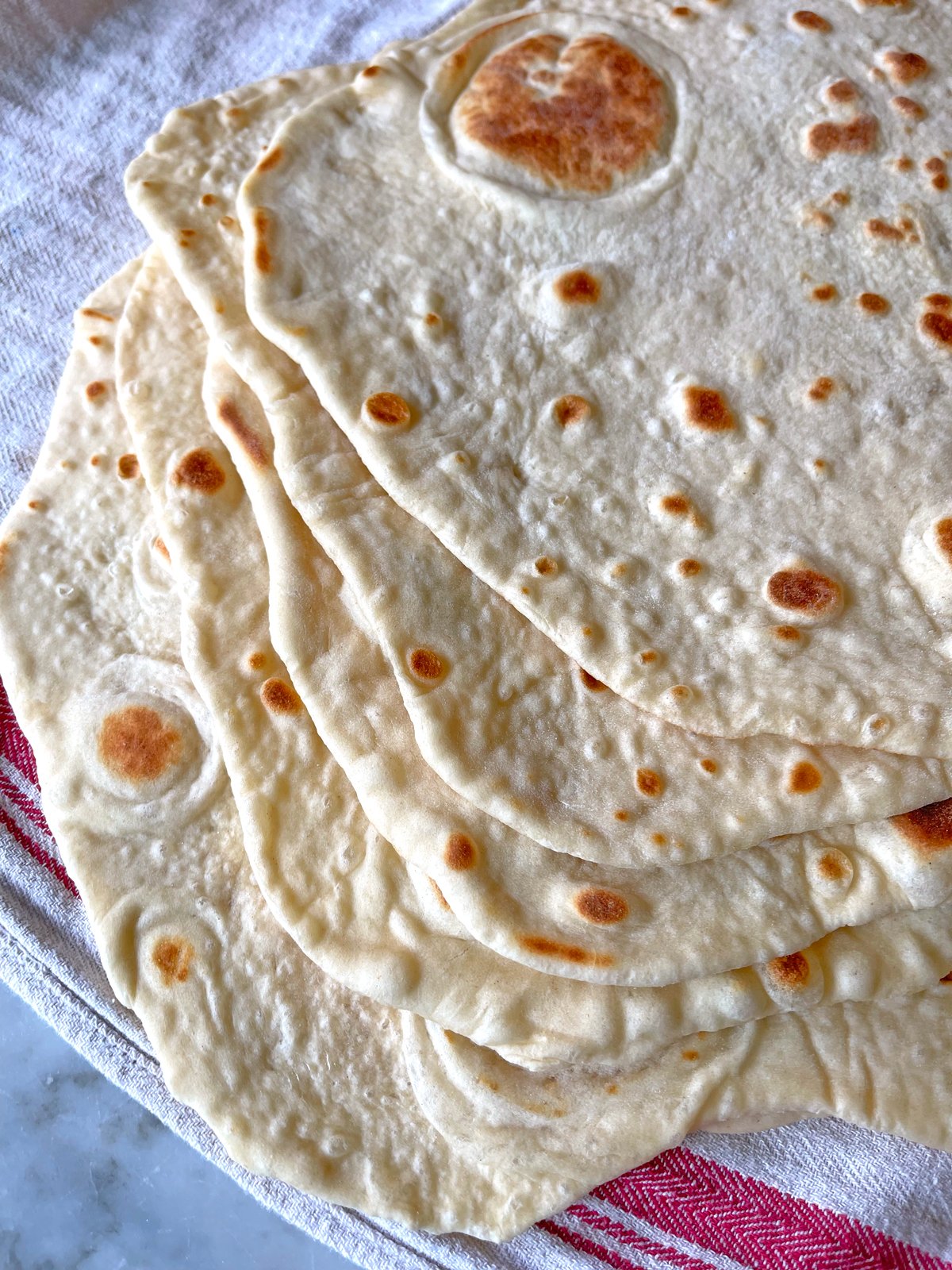
I have always maintained that the best döner kebabs outside of Turkey are found in Germany, a country with a large Turkish immigrant population where döner shops can be found in every city and virtually every larger town. When I was growing up in Germany the döners were most commonly made with Turkish bread that came in huge rounds and were cut into four quarters, each triangle-shaped piece of bread stuffed with the döner meat and veggies. Some shops would also make the huge rounds into smaller, individual rounds of bread. But today another kind of bread is just as commonly used in addition to the traditional round Turkish bread and that is the thin flatbread known as lavash. The kebab fillings are piled in the center of the lavash and then tightly rolled up, wrapped in aluminum foil, and are known as “dürüm”. And while I used to think that nothing could ever equal those amazing döner kebabs that I grew up with, the dürüm versions made with lavash are every bit as good.
The best doner shops make the lavash fresh right then and there. The guys behind the counter grab a ready ball of yeast dough and they press it through what looks like a huge pasta machine and basically functions the same way: the dough goes in and comes out as a large, ultra thin sheet of dough. They then slide the thin sheet of dough into the oven and within a couple of minutes it comes out as fresh lavash bread.
On our recent trip back to Germany our kids went wild over the dürüm kebabs. So as soon as we got home from our trip, I went to work practicing the art of making lavash. And I can tell you that 1) they’re really pretty easy to make and 2) it is SO worth the effort! I made the lavash to serve with my homemade doner kebab meat (yes, that recipe is coming soon too) and it was a massive hit. Mouthwatering Turkish döner kebabs with fresh lavash right at our kitchen table. Heaven!
This recipe makes 12 small lavash flatbreads. If you’re using them to make döner kebab wraps they’ll need to be larger, in which case this recipe will yield 6 large lavash. The size you make will also depend on the size of your non-stick cooking surface. For lavash large enough for kebabs you ideally need a minimum 14 inch non-stick skillet or griddle. For smaller lavash you can use a 10-12 inch skillet.
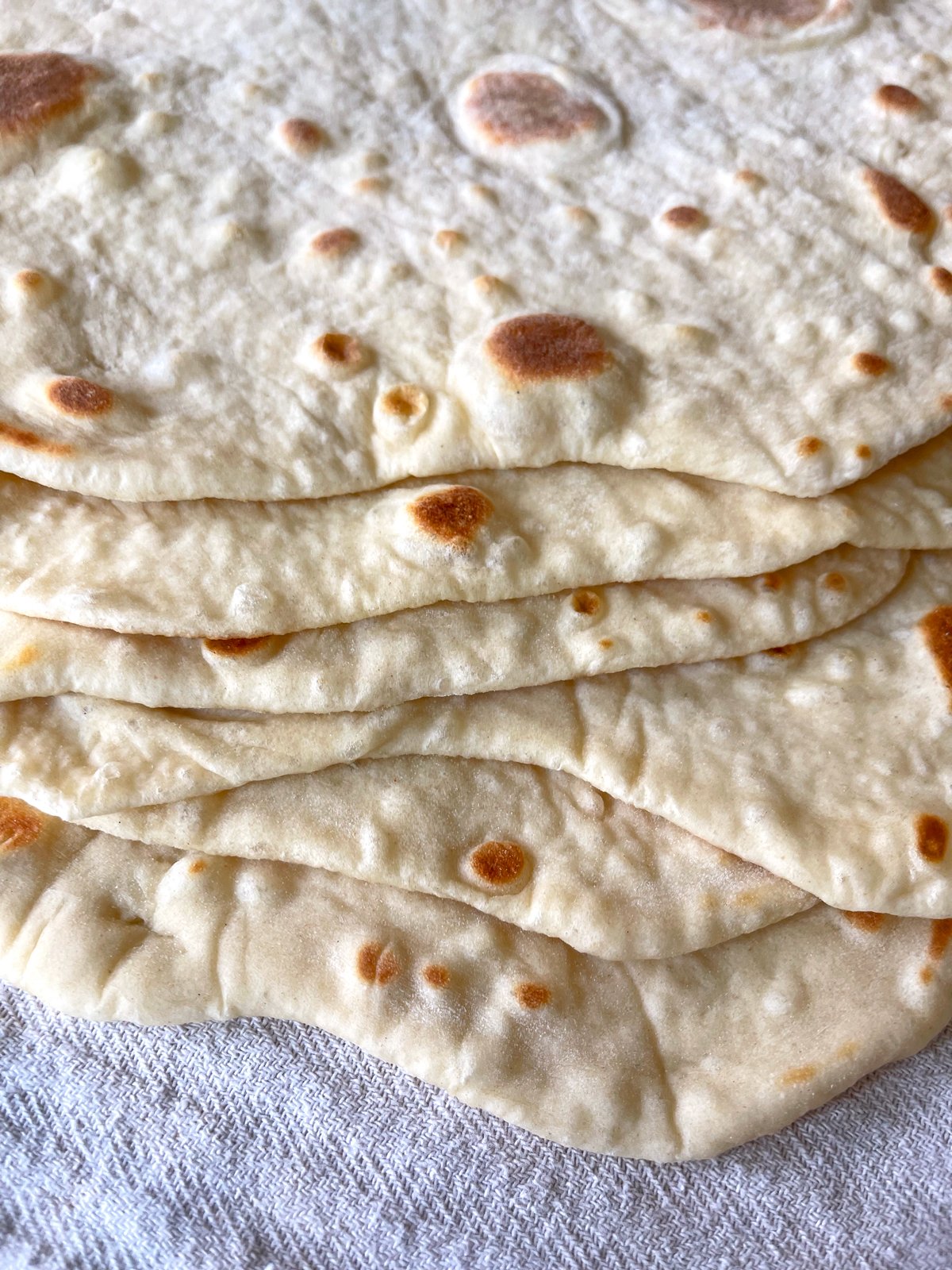
What is Lavash?
Lavash is a simple thin flatbread that has been made and enjoyed for many centuries and is especially popular in Middle Eastern and Mediterranean cuisine, most notably in Armenia, Turkey, Azerbaijan, Kazakhstan and Iran. It is usually leavened, though there are less common non-leavened versions (in Turkey unleavened flatbread is known as yufka). In 2014, the “preparation, meaning and appearance of traditional bread as an expression of culture in Armenia” was inscribed in the UNESCO Representative List of the Intangible Cultural Heritage of Humanity. This traditional preparation of lavash includes baking it in a tonir (aka tandoor), a clay oven heated with fire and wherein the dough is rolled out and slapped against the walls of the oven where both sides are cooked within seconds (from the heat of the clay wall and from the radiant heat of the fire). Hot stones were also traditionally used to cook lavash. Today most home cooks use a tava or similar.
In Armenian cuisine fresh lavash is most commonly used for wraps. It’s also a common practice to dry out lavash and stack them high to be used for later, at which point they’re often broken up in pieces and added to stews. The dried lavash can also be rehydrated and made softer again by sprinkling it with water. In Turkish cuisine lavash is often used to make dürüm wraps for döner kebabs.
How to Use Lavash
Lavash is extremely versatile and can be used in both savory and sweet applications. Here are a few ways to use lavash:
- Wraps and Roll-Ups. Place your favorite fillings in the center of lavash, fold the sides and roll it up tightly. These are also great for breakfast wraps with scrambled eggs, hash browns, sausage or bacon, veggies and cheese.
- Wraps for döner kebabs, shawarma, gyros or falafel.
- Grilled Cheese Sandwiches: add cheese to one side, fold over, and grill.
- Chips and Crackers: cut the lavash into small pieces or wedges, brush with some olive oil, season with spices and herbs and bake in the oven until crispy. Serve them with your favorite dips as a great snack or appetizer.
- Pizza Crust: as a thin, crispy pizza crust, lavash is perfect.
- Dips and Appetizers: cut the lavash into strips or triangles and serve them with dips like hummus, baba ganoush, muhammara, tirokafteri or tzatziki.
- Quesadillas: lavash can be used as a substitute for tortillas.
- Calzones: use lavash dough to make your favorite calzones.
- Garlic Bread: spread it with butter, add garlic and Parmesan, and bake it.
- Substitute for naan bread or dinner rolls to enjoy alongside your main course or with soups and stews.
- Desserts: for a simple sweet treat brush lavash with melted butter, sprinkle with cinnamon and sugar, and bake until crispy. You can also spread the lavash with things like Nutella, fresh fruits, or fruit preserves and roll them up as dessert wraps.
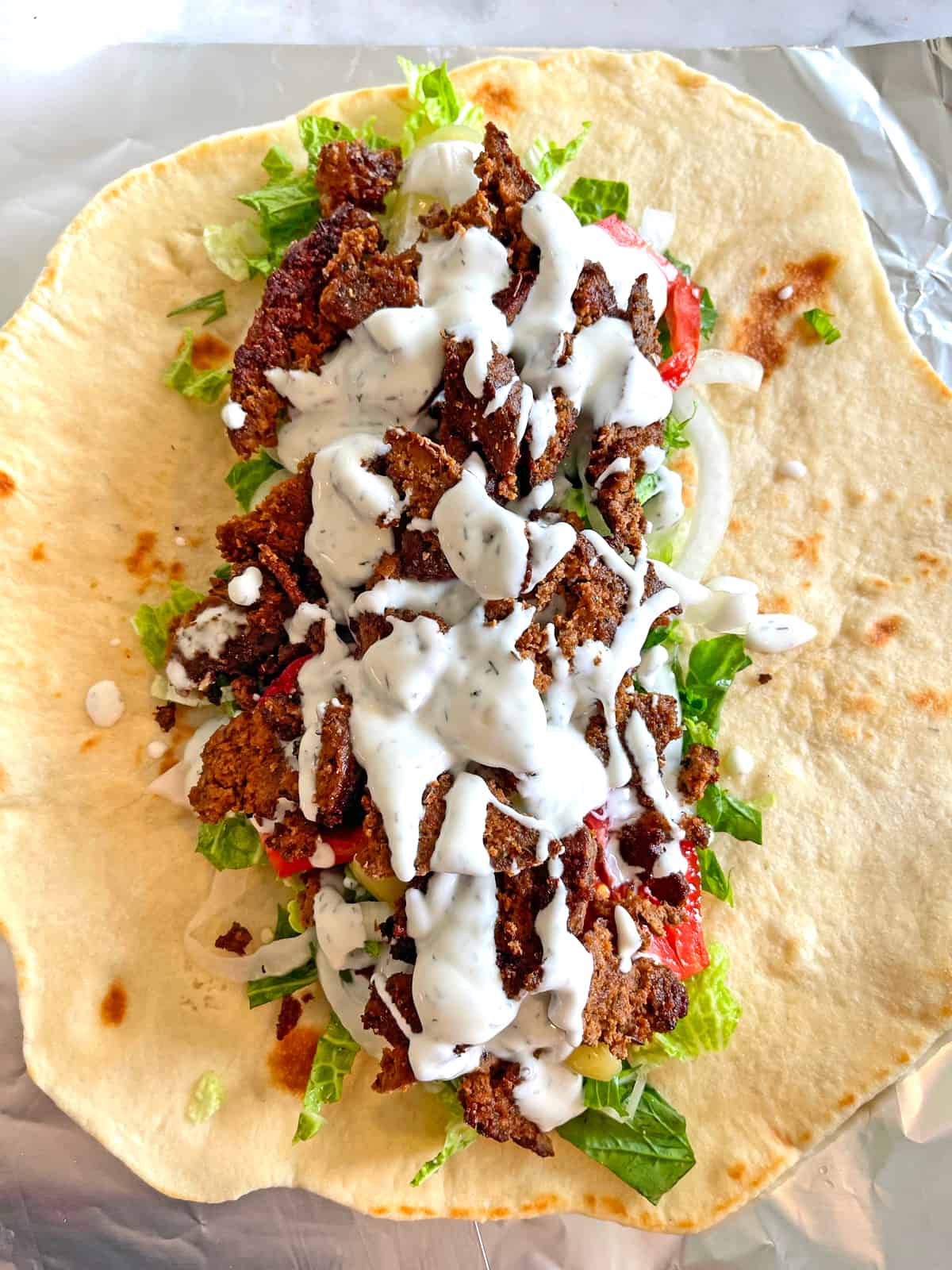
What Type of Flour is Best for Lavash Bread?
Lavash can be made with either all-purpose flour or bread flour, depending on the texture and consistency you want. Both types of flour will produce delicious lavash, but they have slight differences in their characteristics:
- All-Purpose Flour: using all-purpose flour will result in lavash that is softer, thinner, and more pliable. In other words, it’s especially suited for making wraps. It is the most commonly used flour for lavash.
- Bread Flour: this has a higher protein content than all-purpose flour, which will result in a chewier and slightly thicker lavash. Use this if you prefer a heartier, chewier texture.
Either flour is suitable if you’re using your lavash to make pizzas, crackers, or to cut it into wedges for serving with dips.
Tips for Making Thin Flatbread
Depending on what you’re using it for, you may be wanting as thin of lavash as possible. And you’ll notice that trying to roll out yeast dough very thinly is a challenge because it puts up resistance. There is a trick to making the dough more compliant and that involves a longer, slower proof time, but if you’re not in a hurry that’s not a problem. After your dough has gone through the first round of rising you’ve shaped it into individual balls, place those balls in a large covered container (or individual containers if you don’t have one large enough) and place them in the fridge overnight or up to 24 hours. This will give the dough time to relax and make it easier to roll out. When you’re ready to make your lavash simply remove the dough from the fridge and roll it out (yes, it can be rolled out while it’s cold).
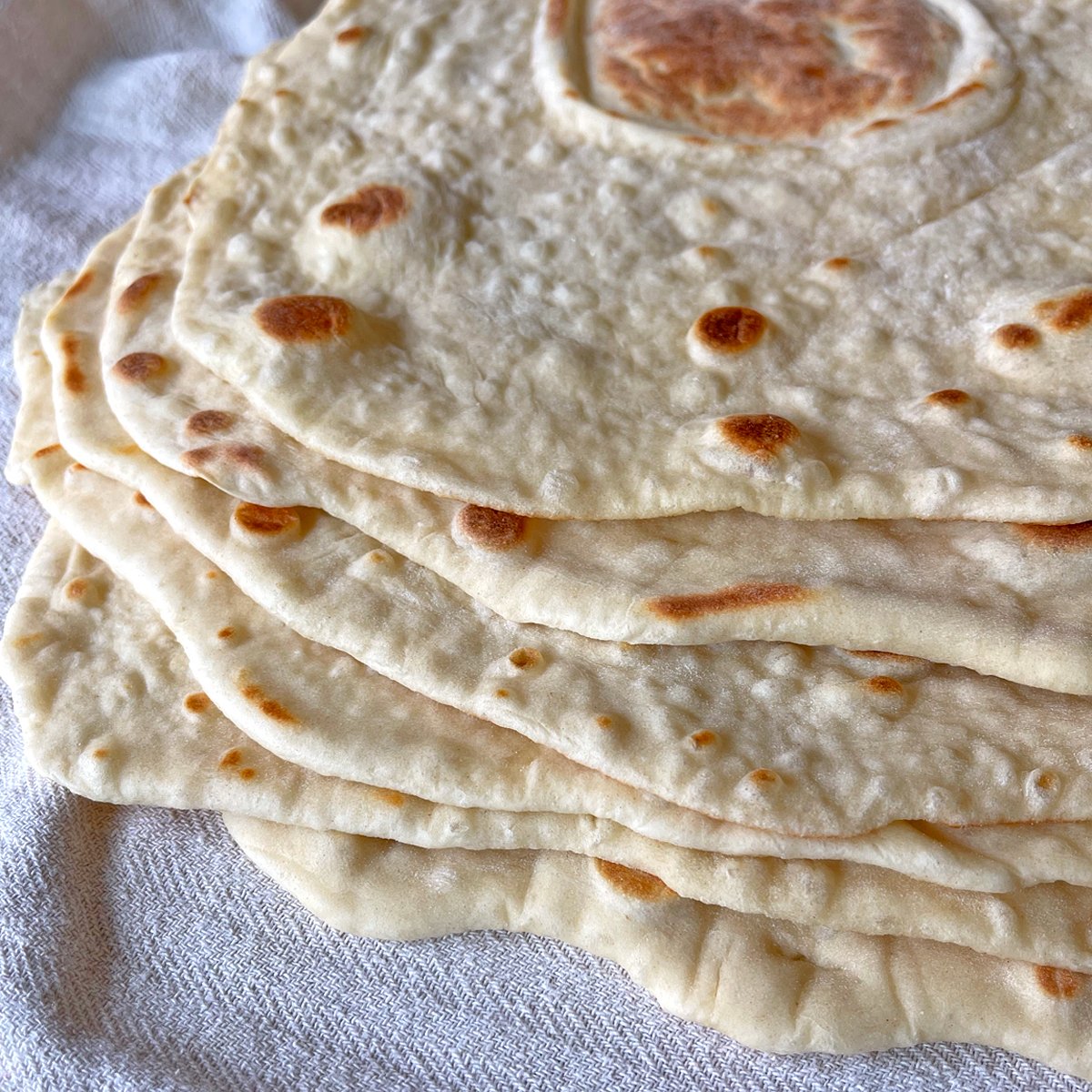
Lavash Recipe
Stir together the water, milk, yeast, oil and honey and let sit for 5-10 minutes until nice and frothy. (This step can be skipped if you’re using instant yeast in which case simply add everything to the flour mixture and proceed.)
In the meantime, place the flour and salt in the bowl of a stand mixer with a dough hook attached. Add the yeast mixture. Knead on “2” until everything comes together in a dough and then continue to knead for 7 minutes. (Alternatively this can be done by hand: knead the mixture until it comes together, then transfer to a floured work surface and knead for 10 minutes.) If the dough is too wet add more flour.
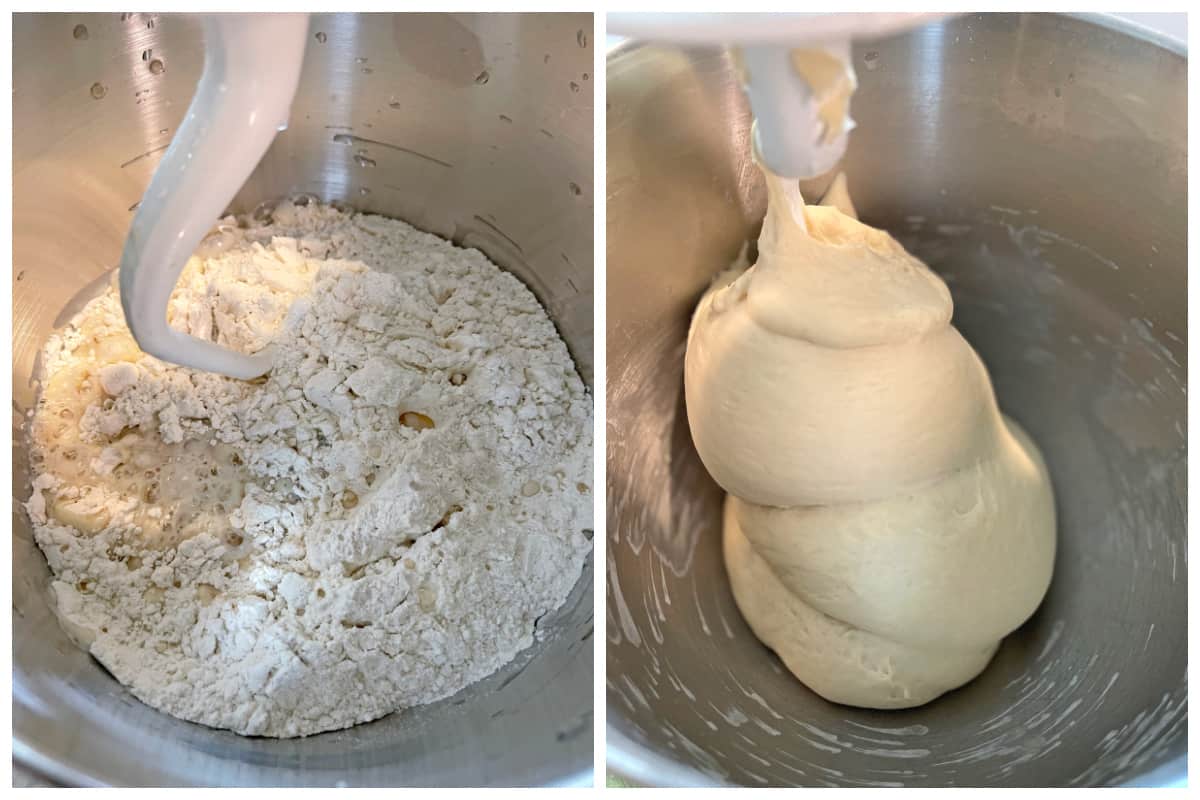
Form the dough into a ball, spray the bowl with oil, return the dough ball to the bowl, lightly spray the dough with oil, cover with plastic wrap and let sit in a warm place for up to an hour or until the dough has doubled in size.
Punch the dough down.
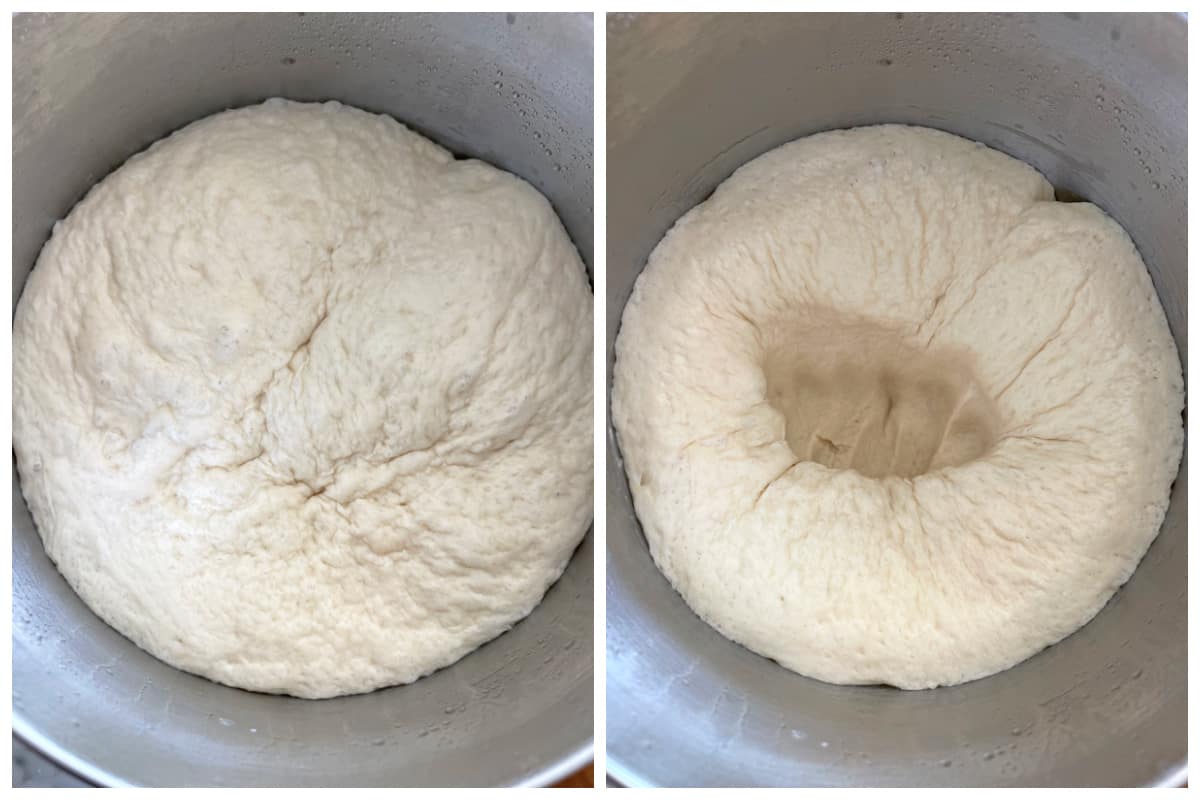
Divide the dough into 12 equal pieces (or 6 if using for larger wraps and you have an extra large skillet or griddle so they can fit), lay them on a lined baking sheet and cover with a towel. Let rest for 10-15 minutes.
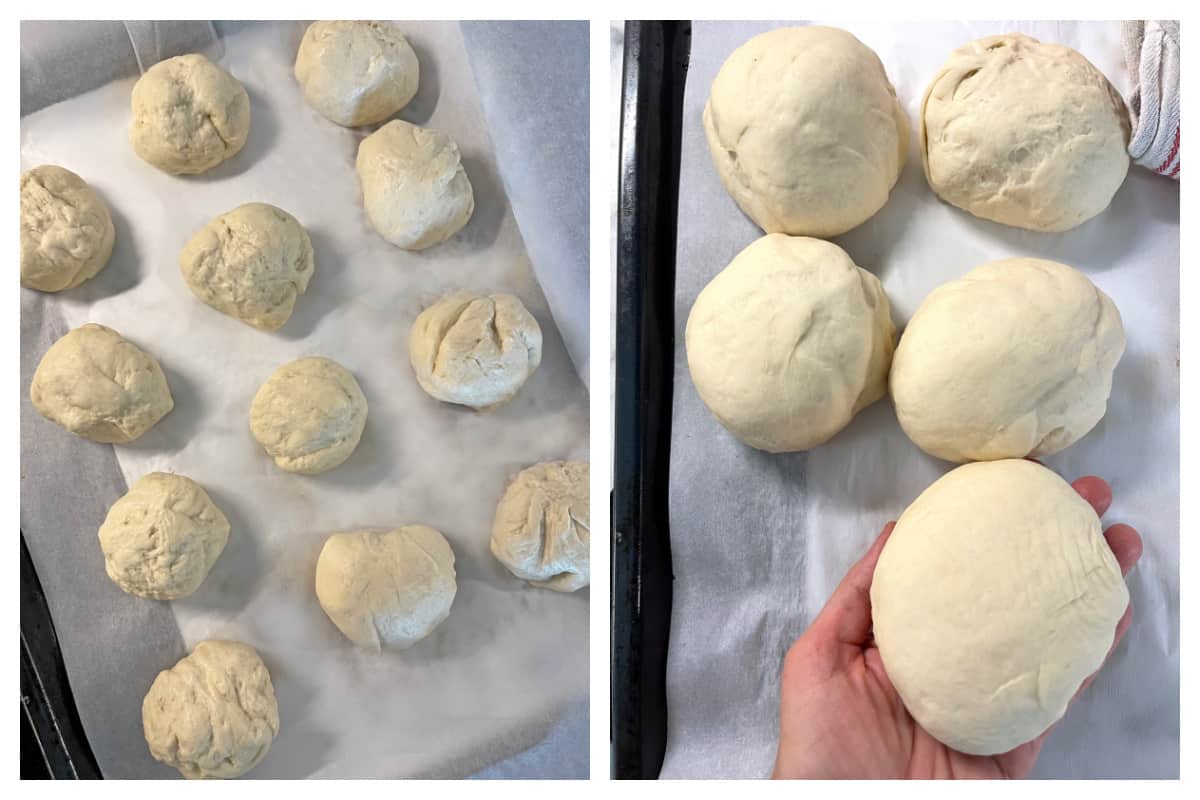
Preheat a large non-skillet or griddle over medium heat.
Transfer a dough ball ball to a floured work surface and roll out a thinly as you can. (See blog post above for tips on rolling it out extra thin.) I’m using my extra large silicone pastry map with measurements that really comes in handy for jobs like this.
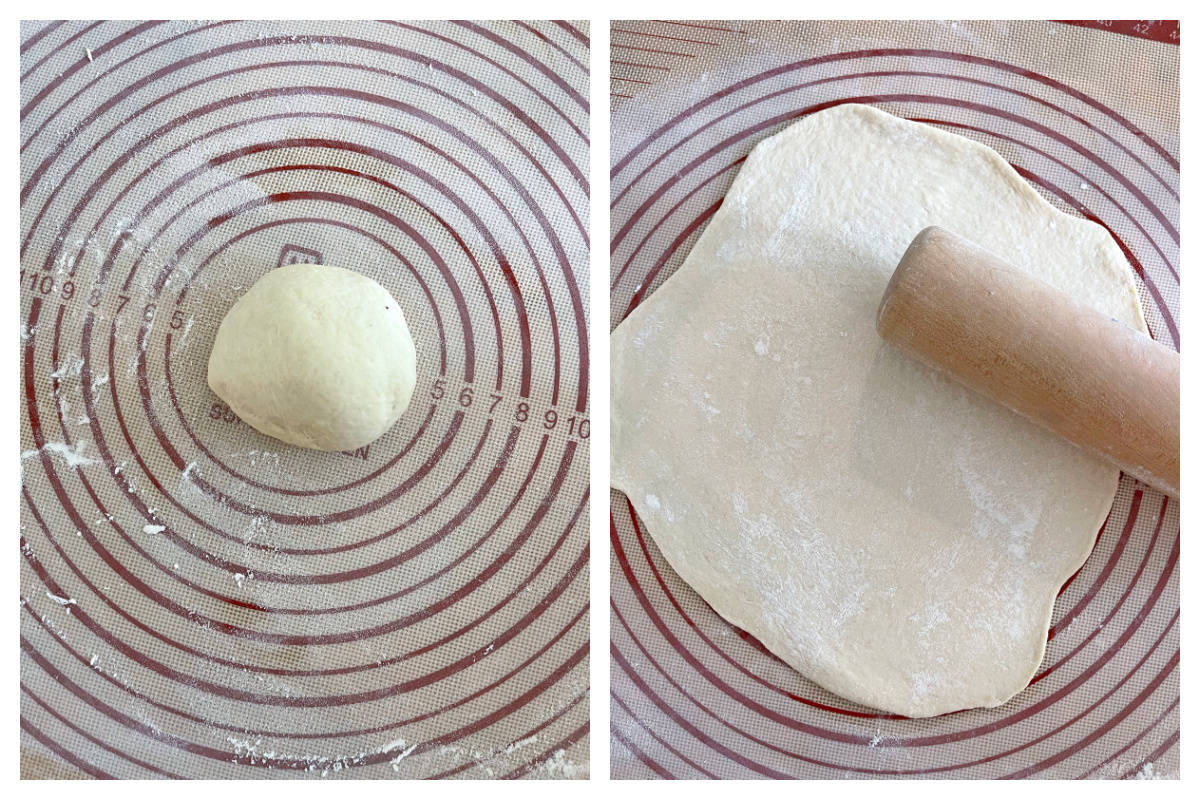
For my larger wraps I’m using my Waring Commercial 16″ Electric Crepe Maker. With a cast iron cooking surface and stainless steel base, this thing is built like a tank and weighs just about as much too. While professional crepe makers come with a hefty price tag, this one is among the most affordable. I’ve been using mine for over 2 years and it does a phenomenal job. I use it to make crepes, pancakes, and flatbreads of all kinds. I absolutely love this thing.
Lightly spray a large non-stick skillet or griddle and place the dough on it. Cook for roughly 45-60 seconds or until the dough bubbles and has some brown spots on the bottom.
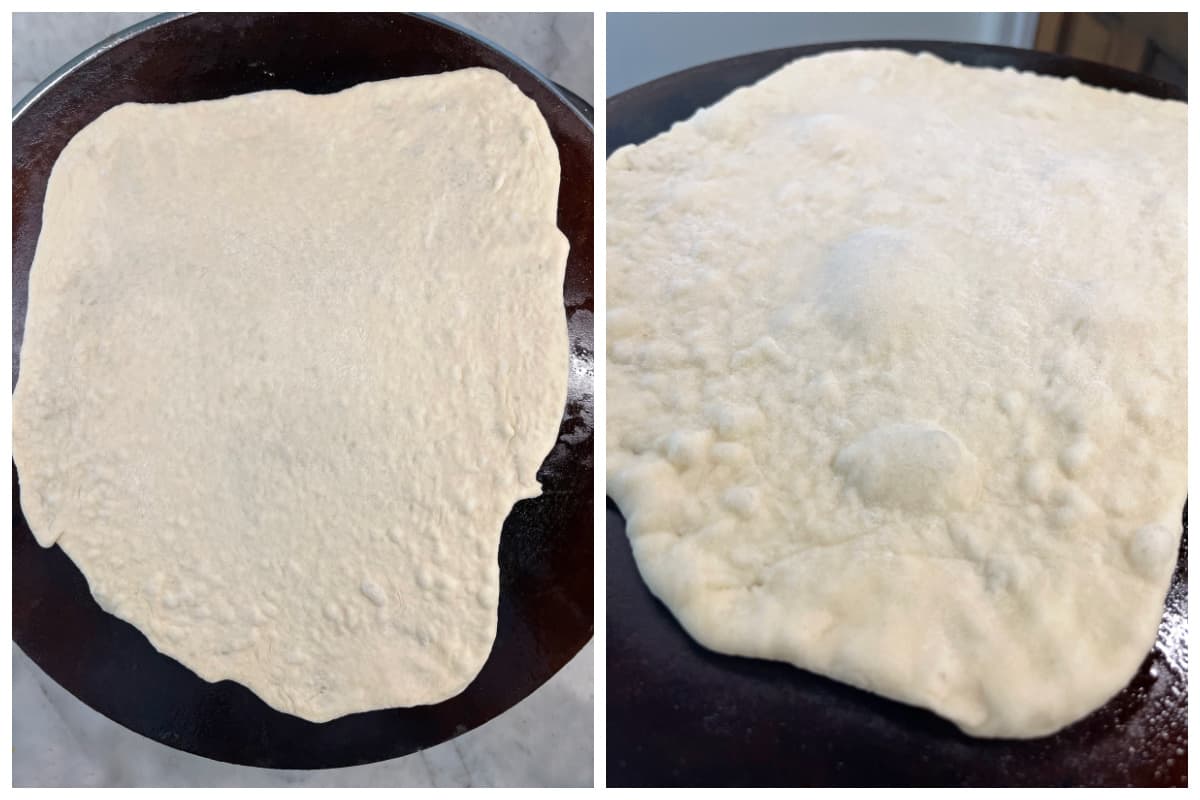
Then flip it over and cook on the other side for another 30-40 seconds.
Transfer to large plate or baking sheet and cover with a towel so it retains moisture. Repeat this process for the remaining dough balls, stacking the finished lavash on top of each other under the towel until you’ve made all the lavash.
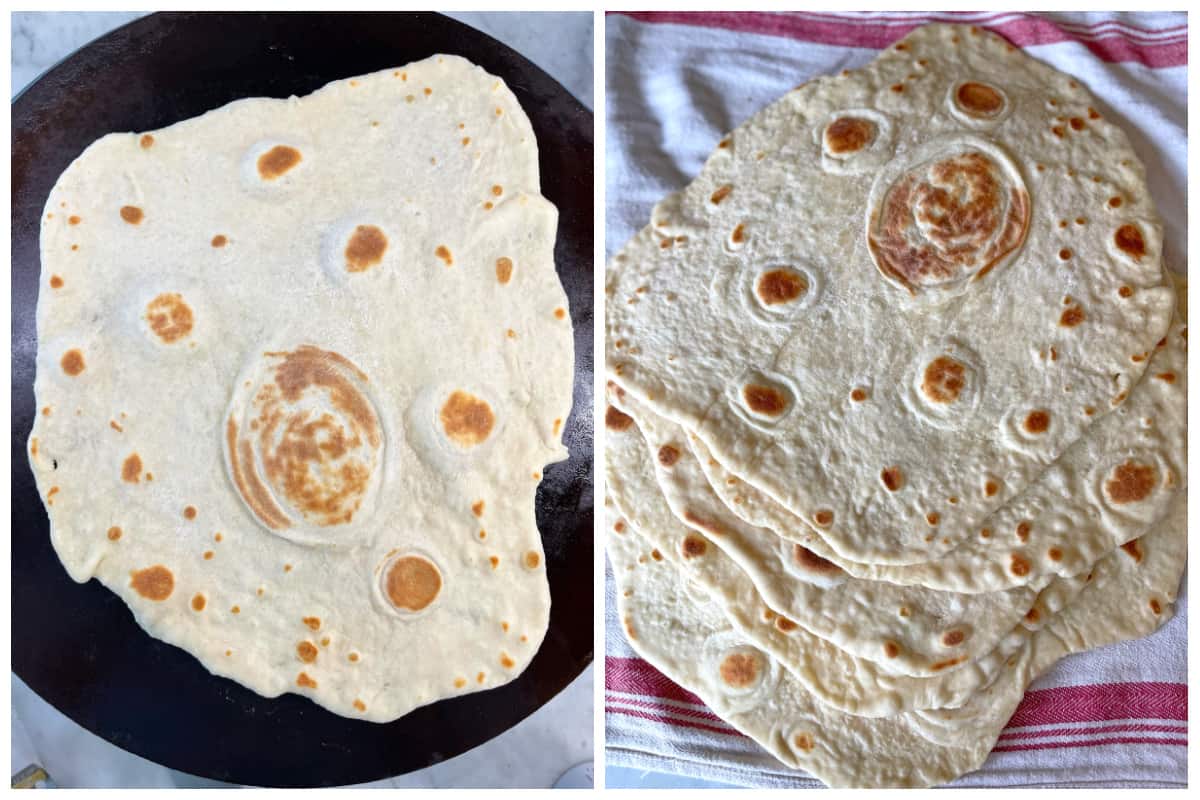
How to Store Lavash Bread
Without a doubt, lavash is best enjoyed fresh, the same day. After the first day it becomes a bit leathery. However you can store it in a ziplock bag at room temperature for up to 2 days and, layered with parchment paper and store in a freezer bag or container, it can be frozen for up to a month. It’s best if you give it a light spray with water and reheat it slowly in the oven.
Enjoy!
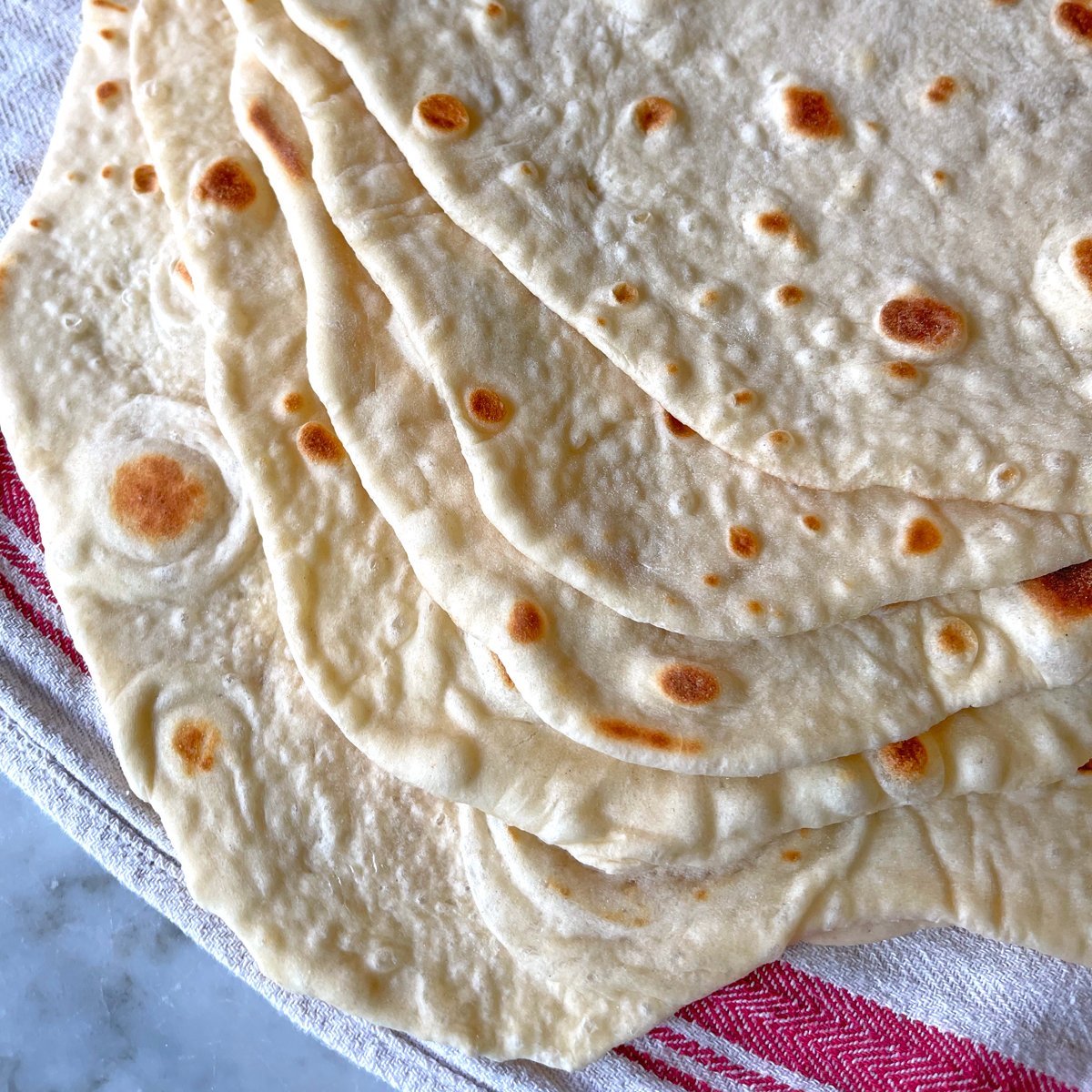
For more delicious breads from around the world be sure to try my:
- Injera (Ethiopian Flatbread)
- Dosa (South Indian Flatbread/Pancakes)
- Lefse (Norwegian Potato Flatbread)
- Naan Bread
- Sourdough Naan
- Danish Rye Bread
- German Bread (Vollkornbrot)
- Crumpets
- Olive Rosemary Focaccia
- Skillet Cornbread
Save This Recipe
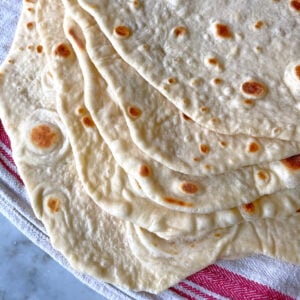
Lavash (Armenian Flatbread)
Ingredients
- 3/4 cup lukewarm water
- 3/4 cup lukewarm milk (milk is not traditional but it makes a softer lavash which I prefer)
- 2 teaspoons active dry yeast , can substitute instant yeast and add it directly to the flour along with the liquids and proceed)
- 1 tablespoon olive oil
- 1 teaspoon honey
- 1 1/2 teaspoons salt
- 3 1/2-4 cups all-purpose flour (see Note about flour type)
Instructions
- Stir together the water, milk, yeast, oil and honey and let sit for 5-10 minutes until nice and frothy. In the meantime, place the flour and salt in the bowl of a stand mixer with a dough hook attached. Add the yeast mixture and knead on "2" until everything comes together in a dough and then continue to knead for 7 minutes. If the dough is too wet add more flour as needed. (Alternatively this can be done by hand: knead the mixture until it comes together, then transfer to a floured work surface and knead for 10 minutes.)Form the dough into a ball, spray the bowl with oil, return the dough ball to the bowl, lightly spray the dough with oil, cover with plastic wrap and let sit in a warm place for up to an hour or until the dough has doubled in size.
- Punch the dough down, divide into 12 equal pieces (or 6 if using for larger wraps and you have an extra large skillet or griddle), lay them on a lined baking sheet and cover with a towel. Let rest for 10-15 minutes.
- Preheat a large non-skillet or griddle over medium heat. Transfer a dough ball ball to a floured work surface and roll out a thinly as you can. Lightly spray the skillet or griddle and place the dough on it. Cook for roughly 45-60 seconds or until the dough bubbles and has some brown spots on the bottom then flip it over and cook on the other side for another 30-40 seconds. Transfer to large plate or baking sheet and cover with a towel so it retains moisture. Repeat this process for the remaining dough balls, stacking the finished lavash on top of each other under the towel. Best served immediately. For best texture enjoy within the same day. To store, place the lavash in a ziplock bag at room temperature for up to 2 days. To freeze layer them with parchment paper and store in a freezer bag or container for up to one month. To serve, spray lightly with water and reheat slowly in the oven.
Notes
- All-Purpose Flour: using all-purpose flour will result in lavash that is softer, thinner, and more pliable. In other words, it’s especially suited for making wraps. It is the most commonly used flour for lavash.
- Bread Flour: this has a higher protein content than all-purpose flour, which will result in a chewier and slightly thicker lavash. Use this if you prefer a heartier, chewier texture.
Nutrition



















Please help, lol. I have no idea what I am doing wrong. This is second lavash recipe I’ve tried with a very frustrating and disappointing experience. :( I’m used to cooking with metric measurements but even with following the US Customary measurements listed, I can’t get the dough to a workable consistency. I feel like I keep adding flour but the dough is still too sticky to knead. I kneaded by hand for 30 minutes, and it will seem like things are coming together smoothly but then it will start to stick to my hands and won’t form a smooth ball of dough like yours is in your post-kneading photo.
Also, I would love to have some additional clues as to how the dough should look and feel after kneading is completed. Should it be tacky at all?
Any suggestions? I’m not sure why I’m having so much trouble despite following the recipe as written and despite adding more flour.
Hi SF, after kneading the dough it should be very soft and should not be tacky. I do provide metric measurements for this recipe – if you look to the right of the list of ingredients you’ll see the option to choose either US Customary or Metric. I’m wondering if the problem you’re facing is because you’re using either British or Australian cups instead of U.S. cups? All three are actually different! All of my recipes use U.S. customary measurements with the option to convert them to metric.
Hi!
Yes, I saw you provided both US customary and metric–I appreciate that! I did try this recipe twice, once using the US customary measurements and then the metric measurements. I’m using US cups. It could be because I’m in the more humid south? I’m not sure why I’m having such a difficult time, I’ve made plenty of breads that have come out lovely but just have not been able to get lavash down!
I will try to adjust the water/flour amounts to get the consistency you are mentioning (soft and not tacky).
Thank you for the quick response.
SF, did you possibly figure out what worked for you? I live in the deep south too💜
I didn’t have the motivation to attempt a 3rd time :(
When I try again, I will provide an update! In the meantime, if you have success and tips, please let me know!
I’ve made this twice, both times with success. I love lavash. The consistency is really no different than pizza dough. You just add more flour or liquid as needed to get that soft but not wet/sticky consistency like pizza dough or soft bread dough. It’s hard to describe and I think bread-making in general can only come through practice and learning to recognize what the consistency should look and feel like. Don’t give up!
Thank you for those insights, Renee, and I’m so glad you enjoyed the lavash! <3
Perfect!! I wanted to duplicate the style bread from the Trader Joe’s vegan lentil wrap.
very happy with this recipe!!!!
I used unsweetened almond milk and didn’t need more than 3.5 cups of flour. next time I’ll add some herbs or spice to the lavash for a richer flavor. thank you!!!!!!
That’s fantastic, Nancy, I’m thrilled that you enjoyed it, thank you!
Thank you for this recipe! Can’t wait to try it. I recently needed to watch what I eat, so I will be making this more often.
This recipe is terrible. 81% hydration????? Really? That’s not dough, it’s batter. Fix the metric measurements.
John Doe, are you kidding? I’m amazed that you know enough about dough to calculate hydration yet clearly know absolutely nothing about bread-making. High hydration breads by their very definition mean they exceed 80% hydration, some even up to 100%. I bake high hydration breads a few times every week. And high hydration for lavash is standard.
The metric recipe’s hydration is too high. Measured all ingredients with a scale and it was far too wet to work let alone roll out thin.
Made this t recipe for lavash today, it was very easy, letting them rest for last 10 min. Going to have them with black bean hummus, babaganush, lebina, morrocan style meatballs with
yogurt cucumber sauce. sliced cucumbers, zucchini sticks.
You are making me very hungry, Paddy! :) I’m so glad they were a success and I appreciate the feedback, thank you!
Having traveled to many of the ME countries mentioned and having lived in the UAE, I have thought it wonderful that every country mentioned as home of lavash, flatbreads, naan and other such breads, has their version, as they do with many recipes with ingredients and spices dependent on what can be best grown in the region. All these countries share many recipes and food, no matter religion or politics.
Excellent recipe, found it better to make 18 dough balls to make them thin enough to bake in my large Le Creuset Dutch oven. Baked them dry instead of with oil and they were amazing.
Really nice texture and flavor. Saving this recipe.
Thank you so much, Sharon, I’m thrilled that you enjoyed it!
This was wonderful!! I’ve made many different types of breads but this was my first time making lavash. The texture and flavor were excellent. I’m making batch #2 tomorrow for making wraps this time. Thank you for this recipe.
Fantastic! I’m so glad you enjoyed it, thank you Shelley!
I wonder, can this be made gluten free? There are three in my immediate family with celiac. Has anyone tried it?
The bread is Armenian (not Turkish), and has been made for many thousands of years. Several thousand before the Turks ever set foot there.
Hi Lyova, that is correct and I’m not sure why the confusion as the recipe title is “Lavash (Armenian Flatbread)”.
I appreciate you making the correction. No confusion on my part for what it was at the time.
No correction was made because none was needed – that was and is the name of the recipe. I also discuss its origins in the “What is Lavash” section.
Hi Kimberly, I’m looking forward to making this recipe. Is lavash the same as naan?
Hi Patricia, it’s not the same but it is certainly similar. Naan uses ghee or butter and often some yogurt while lavash uses olive oil and no yogurt. The texture’s a little different and lavash is also thinner and larger. Happy baking and let us know how it goes!
Dear Kimberly,
I don’t consider myself an expert on bread, or anything else for that matter, but I thought I’d share this with you and my fellow followers on Daring Gourmet. I first heard of this book via NPR and it sounded so radical that I bought the book and tried to follow its recipes. The title is “Artisan Bread”, and the Authors are Jeff Hertzberg and Zoe Francois. Basically, all their bread recipes call for is a ratio of 2 to a scant 1 ratio of flour to water (or liquid). They don’t knead the dough, and essentially follow the rising to double the size of the crumb before forming the loaf and the second rise. Sometimes, because of the ingredients and texture of the crumb, I’m forced to knead the initial dough a little to ensure its homogeneity, and the only way you can decide on its necessity is experience. I’ve been making bread for ~ 40 years and have given away hundreds of loaves over the years. Naturally, the generous recipients rave about its taste. However, I do think it’s quite good and I’m hard to please. I strongly suggest that a few daring souls try it!
Larry
Hi Larry, yes I have that book! :) It’s a good one and Hertzberg and Francois really revolutionized home bread baking with that book. They came out with an updated version a few years later, “The NEW Artisan Bread”, though I’m not sure how different the recipes are. And I just looked it up and lo and behold, they came out with yet another new one two years ago. You mentioning their book also reminded me that they published a “Gluten Free Artisan Bread” book that I was looking at a while back and forgot about. It’s hard to imagine gluten free bread tasting anywhere near as good as the real thing (it doesn’t!) but I’m curious about their approach to it and how it compares to others – I think I’ll go ahead and order it. Thank you for sharing that feedback and your experience with that book with all of us. For anyone interested, here is the Artisan Bread Book that Larry referred to and here is the Gluten Free Artisan Bread Book.
Hi Kimberly,
I enjoyed reading this recipe which bought back wonderful memories of our travels in Turkey. I often prefer baked recipes with a slightly tangy flavor (which is why we make our own yogurt). Would it work well if I substitute yogurt or buttermilk instead of regular milk in this recipe?
Hi Colleen, I’m not sure if the yogurt will provide enough liquid but the buttermilk should work great! Just make sure it’s lukewarm so it doesn’t interfere with the yeast.
Dear Kimberly,
I was so excited to see your lavash recipe title, which you described as an Armenian flatbread.
This is, in fact, an Iranian staple, sold in the thinnest of sheets, slapped up on the insides of a tandoori-type clay oven, hoicked out with an iron prong, and served by the baker in layers upon layers to those who love this type of bread (one of four different varieties that include barbarii, tuftoon and sangyak). Lavash by the way, is a favourite among Iranian shepherds and goatherders. Their simple lunch consists of this form of bread wrapped around goat cheese and onion. Yummy. Tastes best on the day it is made, but my grandmother brought in lavash bakers who made enough bread to last a month, stored in a stone cupboard to keep fresh.
Hi Ingrid, thank you for sharing that, I always love to learn more about the cultural significance of foods. Under my heading “What is Lavash?” I discuss how lavash is enjoyed throughout much of the Middle East, including Iran. For foods that go back so far and are enjoyed so widely, it becomes difficult to try and pinpoint an exact origin. Nevertheless, in spite of several countries sharing lavash in common, it is Armenia specifically that has been granted “UNESCO Intangible Cultural Heritage status” for lavash. However, that doesn’t in any way diminish the bread’s importance to other cultures.